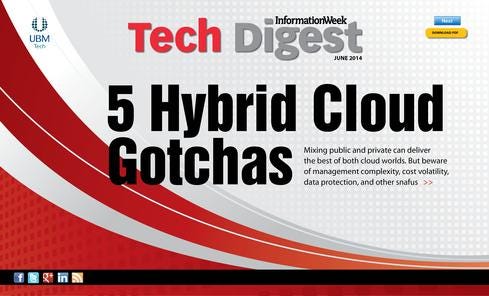5 Hybrid Cloud Gotchas
Mixing public and private can deliver the best of both cloud worlds. But beware management complexity, cost volatility, data protection, and other potential snafus.

 Download the new issue of InformationWeek Tech Digest, distributed in an all-digital format (registration required).
Download the new issue of InformationWeek Tech Digest, distributed in an all-digital format (registration required).
Hybrid clouds are the future of enterprise computing. Forty-seven percent of the nearly 400 respondents to InformationWeek's new Hybrid Cloud Survey have implemented or are actively piloting or developing private clouds, with an additional 33% considering. The majority of that 47% have or are developing hybrid systems, in which workloads can shuttle to public cloud services like Amazon Web Services, Google Cloud Platform, IBM SoftLayer, or Microsoft Azure.
The hybrid movement is extending through all industries. "Because of the nature and culture of our medical center, we are inclined to host the majority [of] our computer activity, services, and applications internally," says one respondent in the healthcare sector. "That being said, due to some consolidation and relationships with other medical groups, we are going to be expanding our resources to include hybrid clouds, where some services remain on site and some are hosted in an off-site cloud, which will include some patient data and potentially some cloud-based video."
That statement illustrates why this trend has legs. Hybrid promises the best of both worlds: the security, control, predictability, and easy access to large legacy data sets of a private cloud closely linked to legacy infrastructure, plus the convenience, scalability, performance, cost, mobility, and collaboration benefits of public, multitenant services.
Unfortunately, there's still no such thing as a free lunch. Hybrid clouds are more difficult to design, integrate, manage, monitor, and secure. They’re almost guaranteed to create friction between siloed IT groups. And unless workloads are well understood and carefully watched, they can generate cost spikes that wipe out expected savings.
Meeting In The Middle
Before we get to these gotchas, let's look at each side of the cloud equation. InformationWeek's latest State of Cloud Survey found software-as-a-service is still the most popular public cloud service, but interest in infrastructure-as-a-service is growing. Platform-as-a-service is also enjoying some good press lately, with containerization generating buzz.
Meanwhile, 77% of respondents to our 2014 Private Cloud Survey have private clouds in production or under development, with 17% stating these clouds are used for most or all of their applications. Cloud adoption is both broad and deep, and for most companies, the debate isn't public versus private, but about how best to aggregate the two.
In fact, in some circles, hybrids are more popular than Priuses on Earth Day, and for the same reasons -- they promise an optimal mix of the best features from two competing technologies. For IT, this best-of-both potential is reinforced by infrastructure management software, like Citrix CloudPlatform, IBM SmartCloud, HP Cloud Service Automation, and VMware vCloud Automation Center, that can control public and private assets from a single administrative console using a unified set of security, user, and application policies.
The business is ready to spend, too. Our 2014 Data Center Convergence Survey shows 22% of respondents will devote more than 20% of their fiscal-year 2014 budgets to achieving convergence, virtualization, and private cloud; 7% will devote more than 30%. Most say that saving money is a top driver. In that report, we discuss using standards to build a hybrid cloud that works seamlessly with public clouds and minimizes the risk of lock-in.
The downside to hybrid clouds is that this is a new model, and it inherits many of the problems besetting both private and public clouds. Ask IT pros what they worry about when using the cloud, and security is usually the first thing they mention, with data protection and privacy a close (and quite related) second. Other top cloud worries: performance, reliability and availability, service and data integration, regulatory compliance, service availability, and cost uncertainty with variable application loads.
Read the rest of this story in the new issue of
InformationWeek Tech Digest (registration required).
About the Author(s)
You May Also Like
How to Amplify DevOps with DevSecOps
May 22, 2024Generative AI: Use Cases and Risks in 2024
May 29, 2024Smart Service Management
June 4, 2024







